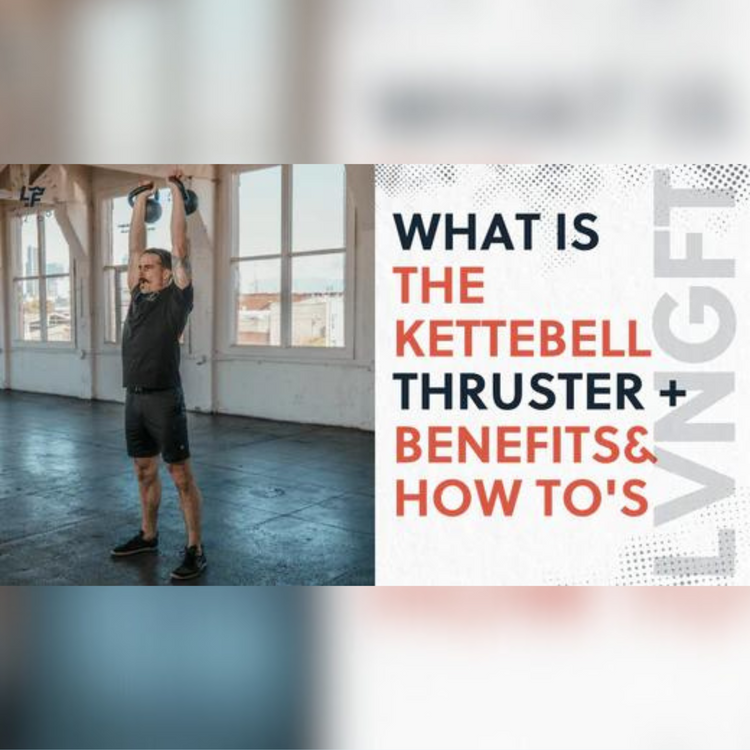Master the Kettlebell Thruster: How-To & Benefits

The thruster is one of those movements that most people have a love/hate relationship with it. It's intensity and it's about as full bodied as an exercise can get. It makes up some of the more dreaded workouts out there, namely "Fran" among others. Being a full body workout also makes it one of the best exercises available. The Thruster can be done with just about piece of equipment, such as barbells, dumbbells, medicine balls, slam balls, etc. However today we are going to discuss my favorite version of it, the Kettlebell Thruster! The kb thrusters are an excellent way to engage your entire body.
The Kettlebell Thruster is one of the best kettlebell exercises available. First of all, it is a combination of two kettlebell movements, the kettlebell squat and the overhead press. Squats use every muscle in the legs, they help improve balance, strengthen core and hips, while primarily targeting quads, glutes, and hamstrings. The overhead press is a fantastic lift for working shoulders and core strength, it targets front and side deltoids and engages the traps, abs and triceps. Together the squat and press make the kettlebell thruster a body workout. This combination might look easy, but it does need a bit of skill and conditioning. The kettlebell thruster benefits are numerous, making it a staple in many fitness routines.
With over 600 muscles being worked, this also makes the kettlebell thruster a cardio exercise without ever having to move your feet! It's a unilateral exercise that has a ton of benefits. Unilateral exercises allow us the ability to train both sides of the body equally. Doing so help avoid overtraining or overusing the dominant side, helps to isolate and correct muscle imbalances, improves balance, utilizes core muscles, aids in injury prevention and facilitates rehabilitation. If you lack stability in any area such as shoulder stability, core, ankle mobility or elsewhere in the body, the kettlebell thruster will expose this weakness and point towards where you can correct it. The kettlebell thrusters muscles worked include the legs, core, and upper body, making it a comprehensive exercise.
Since there is a large amount of muscle activation, the thruster becomes cardiovascular too. The large number of muscles that are used during an exercise, means that more oxygen is required to power the movement. This is a great way to add a cardio element to High Intensity Interval Training (circuit training) without running or needing additional equipment such as a rower or air bike. So, the kb thruster is not only a full body muscle conditioning exercise but also great for your cardio as well as being a big calorie burner. The thruster exercise is perfect for those looking to maximize their workout efficiency.
Due to the size and shape of the kettlebell it forces the body to engage all the little muscles used to stabilize and balance. This alone helps functional movement and prevent injuries. The kettlebell squat is already an impressive exercise that requires muscle activation from the legs, hips, core and back. Once you add the overhead press to the movement then you gain additional muscle activation from the shoulders, arms, upper back and even the chest. The kettlebell thrust is an efficient way to target multiple muscle groups in one movement.
How To Do the Kettlebell Thruster
Part 1: How to Get Setup for Kettlebell Thruster
Kettlebell Thrusters Variations
There are Several Benefits of Two-Arm Kettlebell Thruster
The Goblet Kettlebell Thruster is ideal for beginners. A goblet kb thruster is performed holding a single kettlebell in front of your chest with both hands. It can help reinforce proper movement mechanics of the thruster while at the same time giving the ability to increase weight. In the squat portion of the thruster, you’ll hold the weight in front of your chest with both hands. As you squat down, your elbows will track between your knees while the weight follows. This variation is excellent for those new to thruster kettlebell exercises.
Part 2: The Kettlebell Squat
- Engage your core muscles - Your core should be braced throughout the entire movement. Bracing can help reduce the strain on your neck and lower back. It can also protect these areas from becoming overtaxed.
- Hold your chest and head high looking forward - This helps to protect your back from rounding and neck from straining. When you go into the press keeping a proud chest and head, will help you move straight up rather than pulling you forward.
- Shift your weight into your heels - you should still be able to move your toes throughout the exercise.
- Lower into the squat – while keeping your weight in your heels, imagine yourself lowering yourself onto a chair, hinging at the hips and sending your butt back and down.
- Go Deep - to get the maximum activation of the glutes, make sure your thighs go to parallel or lower than your hips. This will add to the explosive power out of the squat and help transfer that additional power to the overhead press.
Part 3: The Kettlebell Press
Engage the Hamstrings and Glutes - Driving your weight in your heels, load the hamstrings to explosively lift yourself out of the squat and as you raise out of the squat, squeeze your butt to stand tall.
Using the momentum created by the explosive squat…
- Press the Kettlebell Directly Overhead - Don't let the kettlebell drift forward or backwards, while keeping the should away from the ear. As you press the kettlebell overhead lock the knees and elbow to achieve full extension.
Repeat for the desired number of reps.
Kettlebell Thrusters Variations
Up to this point we have been talking about single arm kettlebell thrusters. Like most exercises there are several variations that can be used as well. Using variations can be beneficial to avoid burnout of doing the same exercise over and over. Different but similar exercises will target the same muscle groups but in slightly different ways. There are many different variations that can be done to the kettlebell thruster such as two-arm kettlebell thrusters, goblet kettlebell thrusters, and alternating two arm kettlebell thrusters. These three variations are the ones we will go over in the next part.
Two-Arm Kettlebell Thruster
The two-arm kettlebell thruster, is nearly identical as the barbell and dumbbell thruster variations as well as single arm kettlebell thruster. All the steps we went over in the single arm kettlebell thruster above is the same with this variation, except with two kettlebells. Starting in the front rack position with the elbow under the kettlebells, keeping your chest up and looking straight ahead while descending into a deep squat and explosively driving out of the squat with your weight in the heels and pressing to overhead.
There a Several Benefits of Two-Arm Kettlebell Thruster
- By increasing the deep squat and overhead press the need for better control of two kettlebells, two kettlebells demand the neuromuscular systems to develop greater proprioception and control to effectively perform the movement.
- With challenging the control and stabilization of muscles that are seldom used, the kettlebell thruster can effectively develop shoulder joint stabilization, specifically assisting with injury prevention at the rotator cuff, upper back, and shoulder capsule. Increased neural control and muscular strength can often aid in lower risk of injury.
- Having a proper front rack position, the posterior chain (back muscle groups) and core muscles are engaged to remain contracted and coordinated with integrity. Because the kettlebells are independent of one another, any asymmetries ad imbalances are more pronounced, leading to increased demands on control and coordination on the lifter.
- The kettlebells are a very good tool for performing longer duration work sets to increase anaerobic and aerobic fitness and stamina. The kettlebell thruster is a great movement to increase endurance and challenge the lifters strength and mobility.
The Goblet Kettlebell Thruster
The Goblet Kettlebell Thruster is ideal for beginners. A goblet kb thruster is performed holding a single kettlebell in front of your chest with both hands. It can help reinforce proper movement mechanics of the thruster while at the same time giving the ability to increase weight. In the squat portion of the thruster, you’ll hold the weight in front of your chest with both hands. As you squat down, your elbows will track between your knees while the weight follows.
Holding a weight at the chest activates the core throughout the entire movement, as well as the arms, allowing the body to remain upright and the kettlebell in position. Hold the kettlebell high on the chest will force the chest to remain upright and this will decrease the strain to the lower back.
Due to the position of the kettlebell, when pressing to overhead, be sure to pull your head back to avoid the kettlebell. It is important to keep the kettlebell on a straight path to overhead. To know you are doing it correctly you will momentarily have a double chin and the kettlebell will safely pass by your head.
This variation is often used for better warm-ups and is an incredible way to help with the other variations when done in a warm-up. The counterbalance perfects the downward movement that allows you to engage the core to keep the back rigid and head neutral to help athletes of all levels.
Alternating Two Arm Kettlebell Thrusters
The Alternating two arm kettle thruster is a fun and very taxing variation, it’s also a personal favorite of mine. The setup is the same as the two-arm kettlebell thrust variation that we talked about above. It uses two kettlebells in the front rack position with the load over the elbows. Descend into a deep squat and explosively launch yourself out of the squat.
This is where the variation comes into play. Instead of launching both kettlebells overhead, you only send one. I usually send the left first as I am right-handed, and the left is my weaker side. When the kettlebell leaves the overhead, and reaches the front rack position again, smoothly go back into the squat and repeat. Only this time, go into the overhead press with the other kettlebell.
This is 1 rep!
So effectively this variant is two thrusters in one, increasing the workload and intensity.
Conclusion
The kettlebell thruster is one of the best all over full body kettlebell exercises. This exercise can easily be incorporated in circuit or high intensity interval training (HIIT) as well as be a full body workout on its own! Not only does it activate over 600 muscles per movement, but it works your cardio very hard as well as developing explosive legs and hips. It can be used to develop your strength and power or increase your cardiovascular system.
The kb thruster is a complex movement, so that if you are new to it, you should begin with the goblet thruster variation before progressing on to the one arm kettlebell variation. Also, if you are new to the kettlebell thruster you should start with a light weight until you are comfortable with the exercise and is performed as a fluid movement. If your lower back rounds, you increase your chance of injury to the lumbar spine. So, it is crucial to practice with a very light weight until you master the movements. Care must be taken that the squatting part of the exercise is not neglected and that each repetition involves a proper deep squat.
Author
Coach Jeremy
Jeremy Olson, a husband and father of 2 young boys, is a NASM Certified Personal Trainer, CrossFit CF-L1 and Nutrition Coach, based out of Las Vegas, NV. He is Head of Nutrition at CrossFit Psyched in Henderson, NV and runs the kettlebell program there. He also owns Viking Personalized Wellness LLC, an online fitness, nutrition, and wellness company.
Facebook.com/VikingPW
Instagram.com/lv_viking/
Twitter @viking_wellness










